Summer FAR Ecology Camp 2008 Teaches Environmental Science
To Cambridge Youth
— Daily Reports from FAR Coordinator
by Yannick Perrette, Ecology Camp coordinator, August 14, 2008
text updated August 14, 2008 — images added August 13 & 14, 2008
FAR 2008 SUMMER ECOLOGY CAMP WINDS UP ITS FIFTH WEEK
OF ACTIVITIES AND LEARNING
Thanks to our volunteer participants.
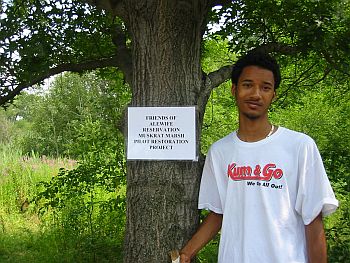
Camper by Muskrat Marsh
|
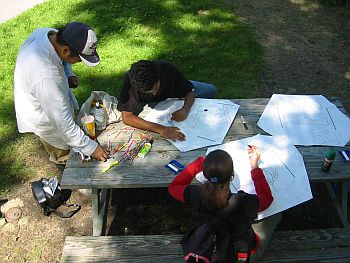
Artwork on kites
|

FAR kite art
|
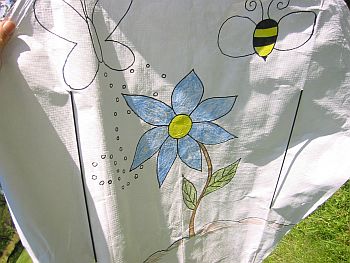
More kite art
|
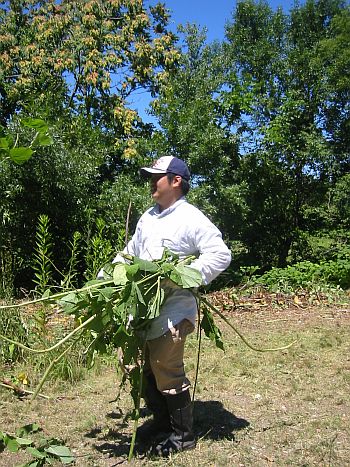
Camper removing Japanese Knotweed
|
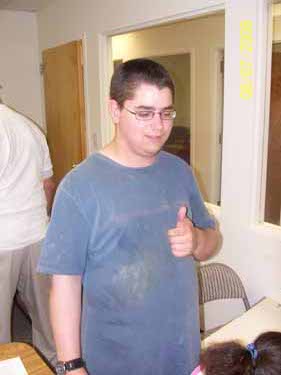
Thumbs up
|
DAILY REPORTS
JULY 7 AM:
First day, 14 youth arrive from Boston Youth Opportunities and from Mayors Summer Youth Employment Program. The orientation and introductions are presented by 2008 summer Ecology camp coordinator, Yannick Perrette. Yannick also had the youth go through a packet he prepared with registration, personal questions to answer and he went through a team building activity, whereby each camper said what he would take into the forest for a week if only one item was allowed. A slide show of 'FAR' is presented and narrated by Ellen Mass, president and founder of FAR who gives the back ground of the camp and the history of the organization and its unique and active role in Cambridge. Ellen explains the problems and needs of the Reservation for the participants and their role in helping to preserve the area. Several workshop leaders and consultants introduce themselves and explain their role. Among those present are John Francis, solar energy, Carol Thrope, bird identification; Michelle Sprengheather, website and climate; and David Marimoto, Lesley University professor, as well as state State Rep. Will Brownsberger. Marie Philippeaux, Supervisor of the Boston Youth Opportunities, and all campers from Boston and Cambridge Mayor's Youth Program introduced themselves, together with Tommy Trainor, supervisor from Cambridge, who comes in regularly to meet with the youth and make sure time sheets are completed accurately and youth are working well with the program.
JULY 7 PM:
John Walker, long time member of FAR took all campers into Reservation and gave handout of the Alewife Reservation history of reservation dating back several centuries. We walked through the reservation goes along North side almost to the pond, with the youth getting used to the woods and quite challenged by the overgrowth of vegetation and working cautiously and safely together. John identifies poison ivy, nettles and invasive species and talks about Muskrat Marsh and the importance of the silver maple forest to the rest of the Reservation.
JULY 9 AM:
FAR professional Tracker, Dave Brown, took the campers down the north side and introduced techniques of how to look for animals by their footprints and excretion. Dave also shows campers plaster imprints of certain species found in the reservation such as deer, fox, rabbits and raccoons. The youth began the practice of going back to 'FAR' office and adding stickers on a large wall map created by Arlene Olivero and set up by Ellen as to how to label things and creatures observed. The map is a consistent means
for the youth to register and work together to identify their observations during the exercise. Four teams of four were sent to put a flag within a quarter mile of the visitor parking lot area and all teams wrote clues for the other teams to be able to locate their flag. Youth were delighted to hide and because of the careful re-writing of the landmarks needed and general directions, each time was able to find the others flag. The team behind the Bulfinch buildings was the first flag to be discovered. Youth returned to label the map with landmarks they had seen during the hunt.
JULY 11 AM:
Richard Scott of the Dept. of Conservation and Recreation and supervisor for the Alewife Reservation, taught all campers how to use a compass and the difference between true North and magnetic North. Richard took 30 potatoes and throws them off the main path and into the grass and forest in order to illustrate his points. The task is to operate like a search and rescue team and find as many potatoes as possible. FAR Campers found 29 out of 30 potatoes. The youth found the exercise and instruction much to their liking and returned very pleased with the exercise. Some youth are still struggling to get into the exercises, but most have acclimated.
JULY 11 PM:
Richard Scott helped campers understand better how a search and rescue team operates. Richard gave examples and stories about past incidents of accidents, problems and how to protect oneself for safety, etc. He explained what his role is at DCR as Supervisor and events steward. Campers asked questions about what to do if lost in a forest. We engaged in discussion about possible related careers and job fields. Richard mentioned park rangers among others.
JULY 14 AM:
David Morimoto took campers to Muskrat Marsh for an exercise using global positioning systems (GPS). The handheld devices were accurate to within one foot, allowing the youth to pinpoint exactly where plants are growing. Campers learned names of several invasive species (purple loose strife, phragmities, oriental bittersweet) and recorded at least five to seven points on GPS to later be inputted into GIS maps. The plan is to do this at the Lesley University labs that Dave has set up for the FAR campers next week.
JULY 14 PM:
Team building has been an important part of the camp. Campers did a short exercise of a trust fall, where one camper falls backwards from an elevated position, into the locked hands of campers awaiting the fall. They did this well and enjoyed it. We returned to 'FAR' office for introduction into WIKI with Michelle and Mihyun Orbanes a former FAR staffer. Campers learned how to do journaling on the web program, enter data and photos and do video on WIKI, for them to view on the internet.
JULY 16 AM:
Rene Morin, supervisor from DCR's Middlesex Fells met campers at kiosk/bulletin board and explained his role as Mystic River supervisor. All campers participated in clearing entire area of Japanese Knotweed, removing it and piling it. Campers were able to finish the whole job by end of morning and Rene was pleasantly surprised at ability of campers to work together despite heat.
JULY 16 PM:
Janet Hobbes, Cambridge art instructor, met campers at picnic tables by visitor parking lot and spent the afternoon drawing with watercolors. She instructed each camper to gather a few leaves, flowers or plants they would like to paint and to do several drawings. She kept the drawings for exhibiting later during camp and for another session for their completion. Many campers complete at least two drawings. Janet was very effective with the youth.
JULY 18 AM:
The Ecology Camp trip to Harvard Museum of Natural History with Stephen Gillies came out especially well. Judith Chupasko kept the youth interested by identifying familiar species from New England. The large mammal collection included over 75,000 stuffed animals. Campers viewed many of the animals found in the Reservation as well as exotic species. Campers participated in a self-guided tour of rest of museum including insects and glass flowers. Yannick, Marie, Pam and Steven guided the group. The response was quite enthusiastic.
JULY 18 PM:
Arlene Olivero, aquatic biologist and FAR member, and Kathleen Attfield of Silent Spring Institute, introduced campers to geographic information systems (GIS) at the Lesley University computer lab. Data from exercise with GPS units is entered into Google earth maps, and campers can see the exact location of GPS points they entered from the Reservation's Muskrat Marsh with David Morimoto. Some of the youth need much explanation and reminders of our guest status at the University, but overall were good learners. The plan is to have the maps uploaded into the youth web WIKI web program that the youth are working on for their own use.
JULY 21 AM:
David Morimoto led campers into Muskrat Marsh again to make quadrants with ribbon tape. Once flagged, the squares are used to count how many of each species (dogwood, purple loosestrife, phragmities) are present in the delineated area so that when it comes time to remove the invasive species, they will know which and how much to remove.
Data is stored for August removal of the FAR Muskrat Marsh restoration pilot program when digging will occur and reseeding will happen. So youth will see a project from assessment to solution. They will also learn the importance of restoring the marsh as restoration is one of the great needs of the Alewife Reservation, and preserving the wetlands near the forested regions as well.
JULY 21 PM:
WIKI session was well received with Michelle Sprengnether. Campers divided into four groups. One group performed a video project and other three groups worked on entering journal and photos into WIKI. Yannick has been taking photos during the camp. Campers are able to see pictures and video on WIKI entered from last week. All new sightings are posted on the GIS wall map as usual with items found or observed registered with date.
JULY 23 AM:
Carol Thrope and David Morimoto take two groups of six campers each and go birding on South side of Reservation, including meadow, paths, and forested area. They carry binoculars and guidebooks. The campers are able to see a red tailed hawk as well as many smaller species of common birds such as sparrows, swallows, red-winged blackbirds, etc. Both groups talked about feeding, migration, habitat and bird calls.
Youth will input their sightings on the map.
JULY 23 PM:
Michelle saw a slide show presentation about climate change and global warming. Basic issues surrounding both were highlighted. Michelle suggested ways for campers to take action to protect themselves, families and the planet. Campers asked lots of questions and had comments about the issues, making for lively discussion and an interest in their future. A demonstration and explanation about different kinds of light bulbs took place. Campers got to take home four compact fluorescent light bulbs each, which they thoroughly enjoyed doing.
JULY 25 AM:
Starting at the visitor parking lot with Don Bockler, a former high school science teacher as our guide, the campers headed towards the Little River equipped with sweep nets and insect identification books. Along the path towards Little Pond they found butterflies, moths, dragonflies and damselflies. Don gave a talk along the way about how insects are aliens and how many insects have co-evolved with flowering plants. Don also talked about the importance of honeybees and gave an overview of the biology, evolution, history and role of bees.
JULY 25 PM:
Janet Hobbs returned to the camp to do more drawing, but this time with chalk as opposed to watercolor and focusing on landscapes as opposed to individual plants, leaves and flowers. The campers were encouraged to do at least 2-3 drawings. The artwork was done at picnic tables, outside in the reservation and campers sat both out on the grass to draw and around the picnic tables. The drawings were incredibly diverse and colorful and we hope to display some of them.
JULY 28 AM:
Cindy Delpapa of the Riverways program came to do a very interactive and participatory series of tests. All the campers were encouraged to do a water analysis. The two tests that were focused on were DO (dissolved oxygen) and PH (acid/base) tests. The procedure was to fill a glass bottle to the top with water, making sure there were no air bubbles. After a series of chemicals were added the water, it changed color several times and then returned to its clear state. In the end, the average PH of the water tested from the Little river was 6.5 and the average DO was 3.75. The campers were also fascinated by a turtle that was sunning itself on a log.
JULY 28 PM:
Arlene Olivero lead an overview of stream macroinvertebrates in the conference room and practices identification with identification sheets and her collection of macroinvertebrates in glass tubes. Campers were exposed to the difference in appearances of macroinvertebrates based on species and life cycle. There is a discussion about what each species can tell you about water quality. Michelle came at 2:00 to spend the last hour entering information into the WIKI with all the campers broken down into small groups.
JULY 30 AM:
The campers stayed inside with Catherine Woodbury from the City of Cambridge DPW. Catherine had a large kit/model of a suburban neighborhood and with it she demonstrated how polluting storm drains can be. She showed the multiple ways that storm drains catch litter, pesticides, car oil, animal feces, etc and that they all get dumped directly into our rivers without treatment. We watched a video highlighting the different ways in which city pollution from our streets and lawns ends up directly in our watersheds. Catherine also talked about CSO's (combined sewer overflows) and that when it rains a lot, raw sewage ends up in the waterways. This also related to our canoe trip coming up.
JULY 30 PM:
Arlene Olivero, Don Bockler and Steven Gillies participated in our hunt for macroinvertebrates. All campers put on their boots and made their way into Yates Pond and Little river to collect Aquatic macroinvertebrates. Yannick put on a full body dry suit and walked into the pond to collect specimens farther from the shore. A diverse collection was sampled and brought back to the FAR office to look at under microscopes. Entire buckets of pond water were sampled and looked at for macroinvertebrates. Rock baskets put out by Arlene over one month ago were also gathered and examined.
AUGUST 1 AM & PM:
After driving over to Little Pond, we met Kent Jackson from the Eagle Eye Institute who introduced us to the world of canoes. Ardeene Goodridge, a peace commissioner from Cambridge also joined us. Kent explained to us the history of canoes, proper paddling techniques, safety measures and then put us into the canoes with either 2 or 3 people per canoe. At first we played a game of "freeze tag" in the canoes. Once warmed up, we started paddling around the pond and then made our way down the little river. We saw a deer, great blue heron and lots of ducks. Most of the canoes paddled all the way down the Little river to the picnic tables not far off from the FAR visitor parking lot and back. Unfortunately, three campers who got tangled in vegetation and were afraid of spiders ended up tipping their canoe. With the exception of that unanticipated swim, the day was a great relaxing adventure. Youth who went into the water, went home for showers.
AUGUST 4 AM:
We spent the morning with Ingeborg Hegemann and an associate at Muskrat Marsh removing invasive species. The beginning of this FAR pilot project started with the Cambridge campers using shovels and loppers to take out multi flora rose, purple loose strife and phragmities. A few native species were flagged to keep, but the majority of the plants were all invasive. This project will continue for several mornings until we have cleared enough of the invasive species to sow some New England wet mix seeds.
AUGUST 4 PM:
Matt Wilson, an environmental consultant associated with the Mystic River Watershed Alliance, spent the afternoon with us talking more about the concept of watersheds, water quality and testing, pollution and related topics. The campers were given glossy maps of the Mystic watershed and located Alewife reservation. The map gave an idea of what water drains into this watershed and we compared it to the continental divide and defined that. Michelle came to do more WIKI journaling and covered what teams would focus on for remaining weeks, as well as figuring out which teams would do video project this week.
AUGUST 6 AM:
It was raining too much to do outside work on Muskrat Marsh. Instead, we watched Pale Male video about red tailed hawk living in New York City and then a few videos on biodiversity, stream restoration and ecology. Campers seemed most receptive to the story of Pale Male.
AUGUST 6 PM:
John Francis (Solar and Environmental Workshops) came to talk about renewable energy. The presentation began with the history of electricity and basic concepts of electricity and then discussing all types of energy and modern electricity production. Fossil fuels were brought up, but John mostly highlighted how solar and wind energy work. He had an array of small solar panels hooked up to a toy helicopter, a self-playing piano, a windmill and a car. All these were powered with a light bulb, as it was raining outside.
AUGUST 8 AM:
Together with Greg from BSC, we continued to remove invasive plant species from the Muskrat Marsh. Purple loose strife and phragmities were dug up and brought to the dumpster. There was quite a lot of water in the marsh as it has been a wet season. There were also some native species such as dogwood and goldenrod that we left in place. We need to spend a bit longer there to be able to have enough of the area cleared in order to spread the wetland seed mix.
AUGUST 8 PM:
John Francis returned for a second afternoon with very hands on projects including a wind turbine kit which the campers assembled and solar panels on a cardboard house that generated electricity for an indoor fan. The campers were equipped with a device to measure the amount of electricity being generated. In the beginning of the session, John asked the campers who would like to be the head of a renewable energy company. A model company was established and the campers volunteered to be part of the solar or wind division. Campers were taught that there are many related renewable energy careers that will be expanding in the years to come.
AUGUST 11 AM:
Susan Agger came to the FAR office to prepare the campers for the nature walk on Friday when they will be taking the Boys and Girls club youth around the Reservation. Susan helped draw out from the campers what they had learned at the camp and break their ideas down into categories that could be useful in talking to the youth as they walk through the Reservation. Susan helped highlight what the campers might say during the walk and encouraged them to have a few talking points as well as reminding them what the best way to address the younger age group would be. We decided the Cambridge campers will divide into two teams of three for the nature walk.
AUGUST 11 PM:
It was the last day to enter text and photos into the WIKI with Michelle. There was a lot of catching up to do, but the session was much more productive because of the fewer number of campers. The Cambridge campers were able to put more detail into their WIKI pages and input the videos that had been taken the week before using Quicktime. The WIKI will be made available to the general public asap and more photos will be uploaded to the WIKI by the FAR team in the weeks to come. Ellen has been working with us this week. While we did not get a lot uploaded onto the website, and the youth were restless, they learned some computer skills. We will also have to reduce the size of the videos and photos to be able to utilize their work.on the site. We will be asking parents for their permission to put the youth under 18 on a p ublic site.
AUGUST 13 AM:
We spent the last day at Muskrat Marsh trying to remove as much purple loosestrife as possible by cutting it low to the ground. We had previously dug out the roots, but this time we focused on cutting the flowers and seeds instead. They were bagged and dumped. When the quadrant that had been flagged was rid of the purple loose strife, we began to seed the area with a one pound bag of wetland wet mix. The campers did most of the seeding with large spice containers that prevented too much seed from coming out at once. This pilot project will be monitored for results over the next year.
AUGUST 13 PM:
Don McCasland from the Blue Hill Observatory came to show us how to make kites from scratch and talk about wind and the history of the observatory. We started the afternoon inside assembling all the pieces and then moved out to the nearby picnic tables to complete them and took time to draw on both sides of the kites. There was just enough wind to lift the kites off the ground and an occasional gust would take them up above the nearby building, about five or six stories high. Each camper was able to fly his/her kite and then was able to take it home with them. Ellen and I also illustrated and made a kite to fly.
| 




